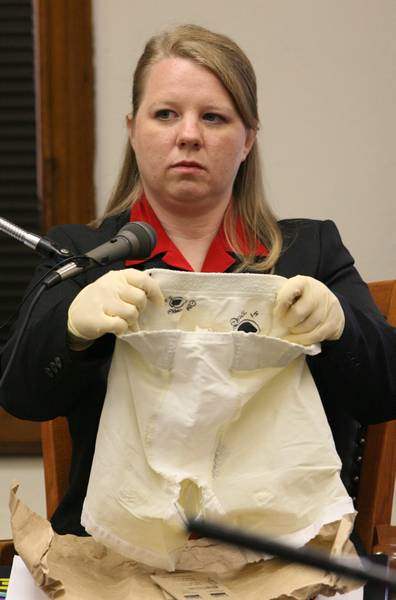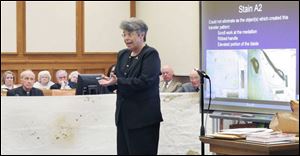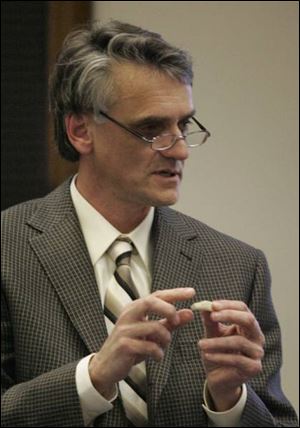
Experts testify on bloodstain patterns, DNA
4/27/2006
DNA specialist Cassandra Agosti said markings near the waistband of the victim's undergarments were inconclusive.

Bloodstain analysis expert Paulette Sutton said markings on an altar cloth could have been made by the letter opener.
Paulette Sutton, one of only five experts in the world certified in the field of bloodstain-
pattern transfer analysis, testified yesterday in the Rev. Gerald Robinson's murder trial that a number of bloody imprints on an altar cloth found at the crime scene could have been made by the priest's letter opener.
Ms. Sutton, assistant director of forensic services at the Regional Forensic Center in Memphis, displayed the bloody, punctured altar cloth for jurors to view in Judge Thomas Osowik's Lucas County Common Pleas Courtroom.
In her hour and 40 minutes of testimony, Ms. Sutton displayed photos and diagrams and pointed out bloodstains and punctures on the 10-foot-long altar cloth, through which Sister Margaret Ann Pahl was stabbed nine times on April 5, 1980 - Holy Saturday.
A number of the stains "were consistent with" the shape and details of the sword-shaped letter opener, Ms. Sutton testified. The letter opener was found by police in Father Robinson's apartment about two weeks after the murder.

Steven Symes, who analyzes wounds by sharp objects, was the 10th witness to testify.
Earlier yesterday, a DNA expert testified that she could not find any evidence of Father Robinson's DNA on the underwear of Sister Margaret Ann or on two altar cloths.
Cassandra Agosti, a former member of the Ohio Bureau of Criminal Identification and In-vestigation, said that while she worked as a BCI scientist she tested a stain near the inside waistband on the nun's undergarments but the stain was too small for conclusive results.
It was "safe to say" that male DNA was in the stain, she said, but she acknowledged that the DNA could have come from a piece of skin or any human cell that touched the garment at any time since the murder, including investigators, people who transported the body, the coroner's office, or crime lab staffers.
An autopsy performed on Sister Margaret Ann the day she died concluded that the nun was not sexually assaulted, even though her body was found partially naked.

DNA specialist Cassandra Agosti said markings near the waistband of the victim's undergarments were inconclusive.
Prosecutors have said they do not plan to use DNA evidence against the 68-year-old priest and thus far have focused most of their efforts on linking the letter opener to the murder.
Ms. Sutton said that with blood-pattern transfer analysis, "we attempt to look at the static aftermath of a bloodletting event" to determine how, when, and where the bloody imprints were made.
She used a rubber stamp as an analogy, saying that when it is covered with ink and pressed down it will leave an image. In the same way, a blood-covered object also will leave an image when it comes into contact with a dry object.
Ms. Sutton examined the letter opener, a medallion that police pried from the instrument, and the altar cloth in March, 2004, at the request of the Lucas County cold-case squad.
She said she covered the nine-inch long letter opener in "stretchy" plastic and then used fake blood to test the patterns it would make on linen.
The instrument's unusual details, including a ribbed handle, an arc-shaped knuckle guard, and the medallion embossed with an image of the U.S. Capitol, left distinct patterns on the cloth in her tests, Ms. Sutton said.
She then gave a detailed review of the larger bloodstains on the actual altar cloth and said some could have been made by the blood-covered letter opener.
In previous testimony, police detectives said the letter opener was suspiciously clean when it was found in a desk drawer after Father Robinson consented to a search of his apartment at Mercy Hospital, where he was chaplain at the time.
Ms. Sutton also used a rubbing from the medallion to show jurors how a circular bloodstain on the altar cloth appeared to contain specific features from the medallion's Capitol image.
John Thebes, one of Father Robinson's four defense attorneys, used tracing paper to outline a photograph of a long, pointed stain on the altar cloth, then turned the tracing paper at an angle and asked Ms. Sutton if it looked like a common household object. Ms. Sutton replied that from that angle it could be the outline of a pair of scissors.
The third witness to testify yesterday and the 10th since the trial began was Steven Symes, a forensic anthropologist from Mercyhurst College in Erie, Pa.
Mr. Symes, who specializes in analyzing wounds made by sharp objects, said he examined the letter opener and a segment of Sister Margaret Ann's jawbone that contained a small puncture wound.
Mr. Symes made casts and molds of the letter opener and the hole in the nun's jaw, and concluded that the letter opener could have been used to make the indentation. He used models of the letter opener and the jawbone to show the 12 jurors and four alternates how the tip of the blade fit the hole in the bone.
He said, however, that the indentation was less than 0.02 of an inch wide and therefore was too small for his research to be definitive.
A section of the jawbone, about three inches long, was removed by Dr. Diane Barnett, a Lucas County deputy coroner, when she conducted a second autopsy on Sister Margaret Ann's body after it was exhumed May 20, 2004, to obtain DNA samples. That particular bone is one of the strongest in the human body, experts testified.
Father Robinson's defense team said it will raise "reasonable doubts" about the prosecution's evidence. One of the points it has argued has been the possibility that the nun's stab wounds could have been made by scissors.
In the slaying 26 years ago - the day before Easter and the day before Sister Margaret Ann's 72nd birthday - Sister Margaret Ann was attacked after entering the sacristy to prepare the chapel for the evening service.
She was choked from behind by her killer, who used a soft ligature, such as a cloth, and squeezed so hard that it broke two bones in the nun's neck, Dr. Barnett testified Tuesday.
Near the point of death, Sister Margaret Ann was placed on the marble floor of the sacristy, covered with the altar cloth, and stabbed nine times above the heart. Those wounds were made in the shape of an upside down cross, so precisely that one detective said he believes the killer placed a cross on her body and used it as a template.
The killer then removed the altar cloth and stabbed Sister Margaret Ann 22 more times. Her undergarments were pulled down around her ankles and her jumper pulled up to her chest.
Father Robinson, who presided at Sister Margaret Ann's funeral, was arrested by cold-case investigators on April 23, 2004. He is believed to be the first U.S. Roman Catholic priest charged in the murder of a Roman Catholic nun.
If convicted, Father Robinson faces a possible sentence of life in prison.
Dr. Henry Lee, the high-profile forensic investigator whose resume includes consulting in the O.J. Simpson murder trial, is expected to testify today in the trial that could last three to four weeks.
Contact David Yonke at:
dyonke@theblade.com
or 419-724-6154.